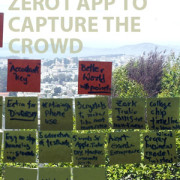Event Recap: At the Mercy of the Crowd(funding)
It seemed impossible to match the frequency outside Gray Area Foundation for the Arts last week on San Francisco’s Market Street when the Giants played the second game of the World Series several city blocks away.
And once inside the no-nonsense GAFFTA location for the panel event At the Mercy of the Crowd(funding), the field of what is possible at the intersections of technology, arts, and culture was alive with a voltage of enthusiasm just as palpable.
The panel addressed the full room full of innovators in a presentation and Q & A that gave new meanings to the terms of pitch, strategy, team, and fans or friends.
Coaching from the panel
The diverse panel was moderated by the Stacy Bond, creator and executive producer of SonicSF. Panelists included Alex Kane, musician; Eleanor Hanson Wise, co-founder of The Present Group; and John Spokes, director of development,
USA Projects.
Stacy introduced her role on the panel with a generous disclosure about how her experience in crowdsourcing funds through Kickstarter had fallen short of their vision for a launch, creating a credible space for sharing not only successes, but the failed attempts that are inevitable and lead to successful strategies through lessons learned. Eleanor described successes of The Present Group in providing a subscription service for clients to receive and view cutting edge on-line art, web hosting with incentive prizes and an experiment in art micropartronage. Alex described his resourcefulness in a college social media marketing class of enrolling class members to make their assigned project his Kickstarter campaign, describing the critical value of a small mass of friends that moved his campaign as a solo musician. He also spoke about the soft value of getting the word out about one’s project through the crowd funding process. John brought a seasoned presence to the panel, describing the role of the artist in the ecology of culture, providing not only an introduction to the philosophical framework of USA Projects, but validating the challenges and gifts of most of the people in the room.
The thrill of the full house that evening generated the kind of intelligent hope and informed commitment to find one’s community and enlarge the spirit and service of that community through your shared vision. The event at GAFTTA offered concrete ideas for how to get your game on as a team so that the crowd (funding) will come.
Take-home tips
- Go together, not alone. Have a supportive circle, a group of friends that can amplify your reach through social media.
- Take confident hold of the important roles played in culture and its economic ecology by artists, tech innovators, and cultural administrators when sustaining the original passion through the long concrete hours of work that goes into project crowd funding.
- Practice pitch perfect; it takes feedback and revision of content to choose the words that get your project’s idea out of your brains and into someone else’s heart.
- Rejection or falling short of the funding goal is an opportunity for clarification.
- Repeat yourself, oh, yes, say it again and again and be sensitive to the timing: a burst of enthusiasm in the beginning, a slump in support after, and a subsequent need for that second wind to bring the project home in the life of your crowd funding campaign.
- Make innovative offers with meaningful benefits to those who give to your campaign and, thereby, become partners in reaching your goal. Cultivate community and involvement.
Thanks to folks at GAFFTA for the open door on Market Street and it’s role in making sense that night of the madding crowd(funding).
About Deborah
Deborah French Frisher is a writer working as project Director for GlobalChill.org, assistant professor in drama therapy at California Institute for Integral Studies, and author of the burgeoning blog her French press.







